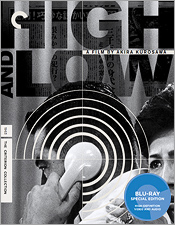High and Low (Blu-ray Review)

Director
Akira KurosawaRelease Date(s)
1963 (July 26, 2011)Studio(s)
Toho (Criterion - Spine #24)- Film/Program Grade: A
- Video Grade: A-
- Audio Grade: A-
- Extras Grade: A-
Review
Though it might seem somewhat surprising source material for a Japanese film, Kurosawa’s 1963 High and Low (the title is also occasionally translated Heaven and Hell) is based in part on writer Ed McBain’s 1959 crime novel, King’s Ransom. Kurosawa’s version once again stars his longtime collaborator Toshirô Mifune, here playing Kingo Gondo, the wealthy factory manager of a leading Japanese shoe company.
As the film opens, we learn that the company’s other executives plan to take their business in a new, more profitable direction, choosing to make lower quality shoes that will wear out faster, thus requiring women to buy them more often. As a man of integrity, this doesn’t sit well with Gondo, so he’s mortgaged his fortune to buy controlling interest in the company’s stock. Just has he’s about to close the deal, however, he gets an anonymous phone call saying that his young son has been kidnapped – unless he pays a huge random, the boy will be killed. Paying the random would mean the end of his takeover bid and his family’s financial ruin, but Gondo is willing to make this sacrifice to get the boy back... that is, until he learns that it was the young son of his chauffeur, and not his own son, that was taken by mistake. So Gondo wrestles with a moral dilemma: Is he still responsible for getting the boy back? Is he still willing to pay? Can he live with his decision?
Whatever else you might call it, High and Low is a master class in the use of staging, deep focus, multi-camera production, sound mixing (Kurosawa’s first use of true stereo) and careful editing to maximize tension. The first half of the film takes place almost entirely in the living room of Gondo’s hilltop home, shot in a series of very long takes. Filmed in 2.35:1 aspect ratio Tohoscope, every portion of the widescreen frame is used to maximum advantage by the director and actors, ratcheting up the drama as first the family itself, and eventually the police detectives, anguish and plan in an effort to gain some advantage over the kidnappers. Kurosawa’s extraordinary attention to detail is in full evidence here: A real house location was used for daytime scenes requiring an expansive view of the city of Yokohama through the living room windows. But for nighttime scenes, the living room was recreated as a set on a soundstage, complete with a model city (featuring moving, lighted toy trains) in the background. The film’s second half (bridged by a thrilling sequence set on a speeding commuter train) then details the extensive police investigation, as a small army of detectives follow the available clues to track the kidnappers through the streets, back alleys and heroin dens of Yokohama, determined to uncover the reasons for the plot and bring those responsible to justice. The investigation is so thorough, in fact, that real Japanese police departments used this film to teach proper procedure for many years. High and Low is simply riveting, and features one of Kurosawa’s all-time best conclusions – a cinematic finale of incredible tension and style (of special note is Kurosawa’s use of the actor’s reflections on glass) – posing yet another moral question that the viewer is left to grapple with for themselves. This is, without question, a work of Kurosawa in his prime.
The Blu-ray version features a gorgeous restoration of the film scanned from a 35mm fine-grain master positive at the proper 2.35:1 aspect ratio. It’s incredibly clean looking, with dirt, scratches, splices, warps and other print issues digitally cleaned away. Nevertheless, fine detail is fairly abundant (though a few shots are optically a little soft). The blacks are deep and rich, though from time to time maybe just a little too deep – it appears contrast may have been enhanced just a bit. Still, it’s a very pleasing image and an improvement over the already fine DVD release. The audio is Japanese DTS-HD MA 4.0, with optional English subs – sonically, very similar in quality to the previous DVD. Dialogue is clear and clean, with good dynamic range. Surround effects are limited, as you’d expect given the film’s vintage, but Kurosawa uses sound here to surprising effect and the mix doesn’t disappoint.
All the extras from the DVD release carry over here, starting with another great audio commentary track featuring Kurosawa historian Stephen Prince, who guides you though the film, highlights its many noteworthy aspects and puts things in context. There’s another 37-minute documentary on the making of the film from Toho’s It Is Wonderful to Create series. You also get a lengthy interview Mifune did in 1981 with the Japanese TV series Tetsuko no heya, along with a recent interview with actor Tsutomu Yamazaki, who played the kidnapper. Finally, U.S. and Japanese theatrical trailers for the film are included, along with a 35-page booklet featuring rare production photographs and liner notes by Japanese cinema historian Donald Richie and author and film critic Geoffrey O’Brian.
The DVD version of this release was already terrific, and Criterion’s Blu-ray upgrade is just that much sweeter. It’s another highly recommended addition to the Collection. Let’s hope more Kurosawa films are on the way to Blu-ray from the company.
- Bill Hunt

